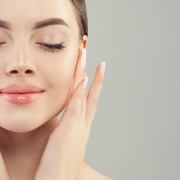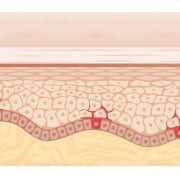Unlocking the Potential of AHA’s and BHA’s in Skincare
When it comes to skincare, there are certain ingredients that have become staples in the industry because of their versatility and effectiveness. Alpha-hydroxy acids (AHA’s) and beta-hydroxy acids (BHA’s) are two such ingredients. These acids have become popular because of their ability to improve a range of skin concerns, from hyperpigmentation to wrinkles and dullness.
AHA’s and BHA’s have distinct properties, but when they’re combined in certain products—especially serums—they offer unique and powerful benefits.
In this article, we’ll explore what sets AHA’s and BHA’s apart, how they work on the skin, and the advantages of using them in tandem.
The Basics: What Are AHA’s and BHA’s?
Both AHAs and BHAs are chemical exfoliants. They help shed the outer layers of dead skin cells, which promotes new cell growth. However, they differ in the way they interact with the skin.
Alpha-hydroxy acids
AHAs are water-soluble acids derived from natural sources. Some examples include glycolic acid which comes from sugar cane, lactic acid which comes from milk, and citric acid which is derived from citrus fruits. Since AHAs are water-soluble, they primarily work on the skin’s surface to dissolve dead skin cells. AHAs improve skin texture, reduce fine lines, and encourage hydration. These benefits are particularly beneficial for dry or sun-damaged skin.
Beta-hydroxy acids
BHAs are fat-soluble, meaning they dissolve in oil. They work to clear pores and minimize blackheads. Salicylic acid is the most common BHA. It’s known for its ability to work within pores to dissolve sebum and prevent clogging. Because BHAs are fat-soluble, they’re best suited for oily and problematic skin types.
The Benefits of AHAs in Skincare
AHAs are renowned for their exfoliating properties, but they offer a range of additional benefits:
- Brighter Complexion
- By exfoliating dead cells from the skin’s surface, AHAs reveal fresher, brighter skin. This promotes a healthy glow.
- Improved Skin texture
- Regular use of AHAs can lead to smoother, softer skin. This is particularly beneficial for individuals with rough or bumpy skin.
- Reduced Fine Lines and Wrinkles
- AHAs stimulate the production of collagen, which is an essential protein that keeps skin firm and reduces the appearance of fine lines and wrinkles. That’s why it’s often used in “anti-aging” solutions.
- Reduced Hyperpigmentation and Dark Spots
- AHAs accelerate cell turnover, which helps fade dark spots and hyperpigmentation.
- Increased Hydration
- AHAs increase moisture retention within the skin by binding water molecules to the skin, which helps keep it plump and hydrated.
The Benefits of BHAs in Skincare
BHAs provide a different set of benefits, particularly for oily and problematic skin types:
- Cleaning out Oil-Filled Pores
- Due to their oil-soluble nature, BHAs can soak into the lipid layers of the skin, allowing them to reach deeper into the pores. They can help dissolve oil, and clear out clogged pores.
- Soothing Properties
- BHAs like salicylic acid are naturally soothing. This property makes them gentle on the skin, even though they work on a deeper level. BHAs can help reduce redness and soothe irritation, making them ideal for sensitive skin types.
- Exfoliation Without Drying
- Some exfoliating ingredients can be harsh on the skin. BHAs exfoliate without stripping the skin’s microbiome and essential moisture.
- Reduction of Blackheads and Whiteheads
- Because BHAs target oil within the pores, they can reduce blackheads and whiteheads, which improves the skin’s overall appearance.
Why Do Some Skincare Products Combine AHAs and BHAs?
Using AHAs and BHAs together can address multiple skin concerns simultaneously. When a high-quality skincare product combines these acids, it can provide comprehensive exfoliation, target different layers of the skin, and treat various issues at once. Here are some of the primary benefits of using products, such as serums, that contain both AHAs and BHAs:
- Enhanced Exfoliation
- Since AHAs work on the surface of the skin, while BHAs work on the oils within, the combination provides a dual-action exfoliation that leaves the skin thoroughly refreshed from the surface to the pores.
- Addresses Multiple Skin Concerns
- Using both AHAs and BHAs means you can address concerns related to texture, pigmentation, and clogged pores all at once. AHAs improve texture and glow, while BHAs improve clogged pores.
- Balanced Skin pH and Enhanced Absorption
- The acidic nature of both AHAs and BHAs helps lower the skin’s pH temporarily, which supports the active penetration of other active ingredients. This maximizes the efficiency of additional ingredients like niacinamide, vitamin C, or hyaluronic acid.
- Reduced Risk of Over-Exfoliation
- Combining lower concentrations of AHAs and BHAs in a single product allows for a gentler approach to exfoliation, rather than using high concentration of a single acid on its own.
Skin Serums as a Delivery Mechanism
Serums are one of the best delivery mechanisms for combining AHAs and BHAs. Their lightweight consistency allows for even distribution and quick absorption of the active ingredients. In general, serums are designed to soak into the skin. Moisturizers on the hand, sit on the surface of the skin and lock in hydration.
Additionally, since serums are usually applied after cleansing and before other steps in your skincare routine, they can create an effective base for the other products and moisture that your skincare regimen involves. This is one of the ways that high-quality serums enhance the overall effectiveness of your skincare routine.
Tips for Using AHAs and BHAs Together
While combining these acids can provide many benefits, it’s important to be aware of the strength and concentration of these kinds of products in order to avoid potential irritation. As you incorporate these acids into your routine, be careful to:
- Start with a patch test: apply the product to a small area of your skin first to ensure there is no adverse reaction
- Use sunscreen daily: these acids increase sensitivity to the sun. Always use sunscreen to prevent damage to the skin from UV radiation
- Monitor frequency of use: you don’t need to use AHAs and BHAs daily. A combination serum can be used two to three times per week and still be effective. Find the rate of use that works for you and your skin type
In Conclusion
AHAs and BHAs are staple ingredients in skincare products respectively. But the benefits of combining these ingredients in one product are remarkable. An AHA/BHA serum can provide a balanced, multi-functional approach to skincare. Whether you’re looking to brighten, smooth, or clear your skin, these acids are a crucial part of almost any skincare regimen.
Enjoy a more radiant, youthful complexion with AHAs and BHAs.













